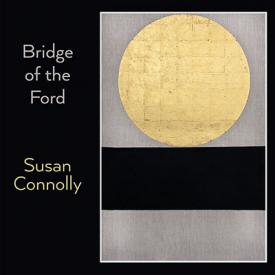Bridge of the Ford
s
s u n
n
s
s e t
t
the the the the the the the the the the the the the the the
CrookCrookCrookCrookCrookCrookCrookCrookCrookCrookCrookCrookCrookCrookCrook
road road road road road road road road road road road road road road road
Most poets prefer to work with a laptop or perhaps a pen and paper. Inspired by the concrete poets of the 1960s and 70s, over the past ten years, Susan Connolly has honed visual poems with the aid of scissors, glue stick and a typewriter. In her third solo collection Bridge of the Ford, Connolly invites her readership to explore her home province in Eire: the Boyne Valley, Drogheda.
The collection is divided into two sections; “Bridge of the Ford” and “The Dream Clock”. The first opens with “Winter Solstice at Dawn, 3pm” and we are greeted with a calm, considered layout. Two columns of text frame loosely placed letters, creating the feeling of a slow flowing river. Harmony is achieved both in the physical symmetry of the layout and in another sense by Connolly’s use of cosy, tender phrases like “hunkered down” .
The pages to follow continue to meander, leading the reader lovingly through the landscape. Connolly uses visual tricks and puns to create imagery and convey a sense of place. She successfully pairs phrases such as “sunset renews fading patterns” with typography which subtly contrasts light and bold letters which appear to shimmer on the page. By comparison “MUIREDACH” lacks the flow and delicate qualities of the other poems in the collection. It sits densely in the white space, visually halting the reader unnecessarily.
Some of Connolly’s word play is more deft in some places than in others; the mini map of the area using the old names for the town, works quietly; elsewhere the several times repeated typographical trick of the use of the word “bridge” placed to resemble a bridge was rather more obvious. These devices add a pleasing tension to the collection encouraging opportunities for rereading and rediscovery. In “Flute solo in the Afternoon” Connolly demonstrates how powerful sound can be, using “flflflflflflflflute”, encouraging her reader to read aloud and to really listen.
Moving through the collection, it becomes more daring and energetic: Connolly begins to paint scenes with her words. Consider particularly “Looking Four Ways – the seawall, Baltay” where she composes her surroundings; by using “river” triangles to create a ripple through white space; using a large rectangle of several “wallwallwall” Connolly illustrates bricks. She treats the page as a painter would a canvas and places her text considerately to envisage the scene. Connolly suggests she is not content with creating a static image; her layouts are energetic and she uses techniques to suggest a sense of time, such as; “sun” followed by “set” in the last-mentioned poem. There she also types “peacock screech” in the area representing the sky, suggesting she wants the reader to “hear” and become absorbed in the place she has depicted.
The second section in the book “The Dream Clock” is a collection of poems with roots in the holy books of Kells, Durrow and Lindisfarne. This collection of poems doesn’t run as easily as the first half of the book, but nonetheless they negotiate their pages well. In particular I enjoyed “Twenty-three Snowflakes” inspired by Alexander Calder the inventor of the mobile. The twenty-one letters are joined by numbers 2 and 3 to total twenty-three characters, sprinkled across the page, in differing sizes, and some printed backwards, successfully resembling the fragility of falling snowflakes.
Overall Susan Connolly takes a lovingly detailed journey through the Boyne Valley, truly observing her surroundings and expertly manoeuvring her reader along, by playing on all the senses. Her puns and visual trickery make this an exciting collection, which is formally adventurous in its fulfilled mission to create such a rich sense of place.
Katie Parkin


Leave a Reply